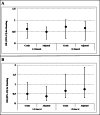Food groups intake in relation to stunting among exceptional children
- PMID: 32819323
- PMCID: PMC7439662
- DOI: 10.1186/s12887-020-02291-7
Food groups intake in relation to stunting among exceptional children
Abstract
Background: Although several studies have examined the link between different food groups intake and stunting among children, no study, to our knowledge, was done on exceptional children. The aim of this study was assessed the association of dietary intake and stunting in Iranian exceptional children.
Methods: This cross-sectional study was conducted on 470 exceptional children (226 mentally retarded, 182 deaf and 62 blind children), aged 5-15 years. Height was measured using standard tool. Stunting was defined as height-for-age z-score of <-1. A validated dietary habit questionnaire was applied to assess dietary intakes.
Results: Mean age of children was 10.02 ± 2.04 years. Stunting was prevalent among 50.6% of children. Compared with children in the lowest category of dairy consumption, those in the highest category had lower odds of stunting. This association remained significant even after adjusting for covariates (OR: 0.50, 95% CI: 0.29-0.87). In addition, moderate consumption of egg (1-3 time/wk) was inversely associated with stunting either before or after controlling for potential confounders (OR: 0.36, 95% CI: 0.21-0.64). Such finding was also seen among mentally retarded children (OR: 0.38, 95% CI: 0.16-0.89). No other significant association was seen between intakes of other food groups (including meat, fruits and vegetables) and stunting.
Conclusions: We found that higher intake of dairy products and egg was associated with lower risk of stunting. However, intakes of other food groups including meat, fruits and vegetables were not significantly related to stunting.
Keywords: Diet; Exceptional children; Food; Height; Stunting.
Conflict of interest statement
The authors have no conflict of interest to disclose.
Figures
Similar articles
-
Household dietary diversity and child stunting in East Java, Indonesia.Asia Pac J Clin Nutr. 2017 Mar;26(2):317-325. doi: 10.6133/apjcn.012016.01. Asia Pac J Clin Nutr. 2017. PMID: 28244712
-
Major dietary patterns in relation to stunting among children in Tehran, Iran.J Health Popul Nutr. 2013 Jun;31(2):202-10. doi: 10.3329/jhpn.v31i2.16384. J Health Popul Nutr. 2013. PMID: 23930338 Free PMC article.
-
Association between Dairy Intake and Linear Growth in Chinese Pre-School Children.Nutrients. 2020 Aug 25;12(9):2576. doi: 10.3390/nu12092576. Nutrients. 2020. PMID: 32854304 Free PMC article.
-
A Systematic Review Investigating the Relation Between Animal-Source Food Consumption and Stunting in Children Aged 6-60 Months in Low and Middle-Income Countries.Adv Nutr. 2019 Sep 1;10(5):827-847. doi: 10.1093/advances/nmz018. Adv Nutr. 2019. PMID: 31177279 Free PMC article.
-
Onset and evolution of stunting in infants and children. Examples from the Human Nutrition Collaborative Research Support Program. Kenya and Egypt studies.Eur J Clin Nutr. 1994 Feb;48 Suppl 1:S90-102. Eur J Clin Nutr. 1994. PMID: 8005095 Review.
Cited by
-
Infant age at egg introduction and malnutrition-related child growth in the United States.Matern Child Nutr. 2022 Oct;18(4):e13390. doi: 10.1111/mcn.13390. Epub 2022 Jun 16. Matern Child Nutr. 2022. PMID: 35712809 Free PMC article.
References
-
- Geberselassie SB, Abebe SM, Melsew YA, Mutuku SM, Wassie MM. Prevalence of stunting and its associated factors among children 6–59 months of age in Libo-Kemekem district, Northwest Ethiopia; A community based cross sectional study. PloS One. 2018;13(5):e0195361. doi: 10.1371/journal.pone.0195361. - DOI - PMC - PubMed
-
- Eid A, Omar A, Khalid M, Ibrahim M. The Association between Children Born Small for Gestational Age and Short Stature. J Preg Child Health. 2016;3(220):2. doi: 10.4172/2376-127X.1000220. - DOI
-
- Organization WH. WHO child growth standards: length/height for age, weight-for-age, weight-for-length, weight-for-height and body mass index-for-age, methods and development. World Health Organization; 2006.
Publication types
MeSH terms
Grants and funding
LinkOut - more resources
Full Text Sources


